meta: The Meeting With the Goddess: Journey to the Centre of the Tardis
In which the World Tree is blatant, the Tardis is a Goddess, Clara's lessons about Death continue, the Doctor is in denial, Clara is most certainly not an android and a million other very interesting things occur.
The World Tree and Tardis as Goddess
For a while I've been going on and on about World Tree symbolism in Moffat's Who, which, in this series, has become overt. The World Tree is a spiritual symbol found across many cultures and time periods, that uses the image of a Tree in order to depict life, the Universe and everything. It portrays the forces that make up reality, and the journey of living things within that reality.
In this episode, the Tardis herself is represented as containing a literal tree which has the ability to pattern particles and to create anything the user desires. For me, this core part of the Tardis symbolises that both the Tardis herself is a symbol of the World Tree and that she is the equivalent of the force that creates the World Tree/Universe. She represents the force that lies behind reality. We're shown over and over in this episode, both in dialogue and in plot events, that the Tardis is a complex, living, creative, vastly powerful entity with infinite form, with the power to both create and destroy held in balance (also represented by the Eye of Harmony), a being with powers of a Goddess. That the Tardis represents the Goddess is also very relevant when it comes to looking at where this episode might fit in the structure of Joseph Campbell's Heroic Journey.
The circular Gallifreyan patterns behind the self-destruct countdown on the monitor resemble the structure and spheres of the Kabbalistic World Tree. The Kabbalistic World Tree, from the esoteric Judaic system, depicts a series of spiritual principles in the form of spheres that are connected together in the abstract form of a Tree of Life. These principles describe how the Universe was created out of nothingness by the Divine, how the Divine can be discerned in the world around us, the path of the human soul through reality, and how the soul ascends by becoming closer to the Divine. The Kabbalistic World Tree is essentially a map of God(dess), reality, the entire nature of the Universe and the role of living things within it. It's everything. Note the similarity between the circular Gallifreyan and the traditional depiction of the Tree.
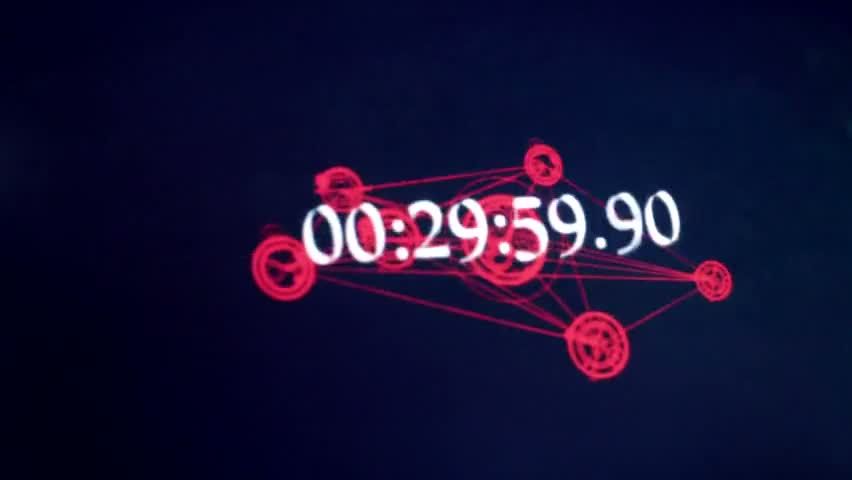
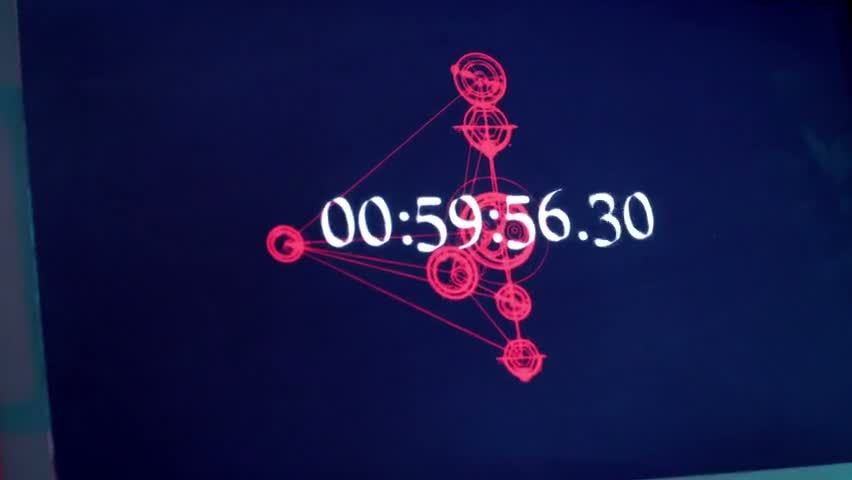
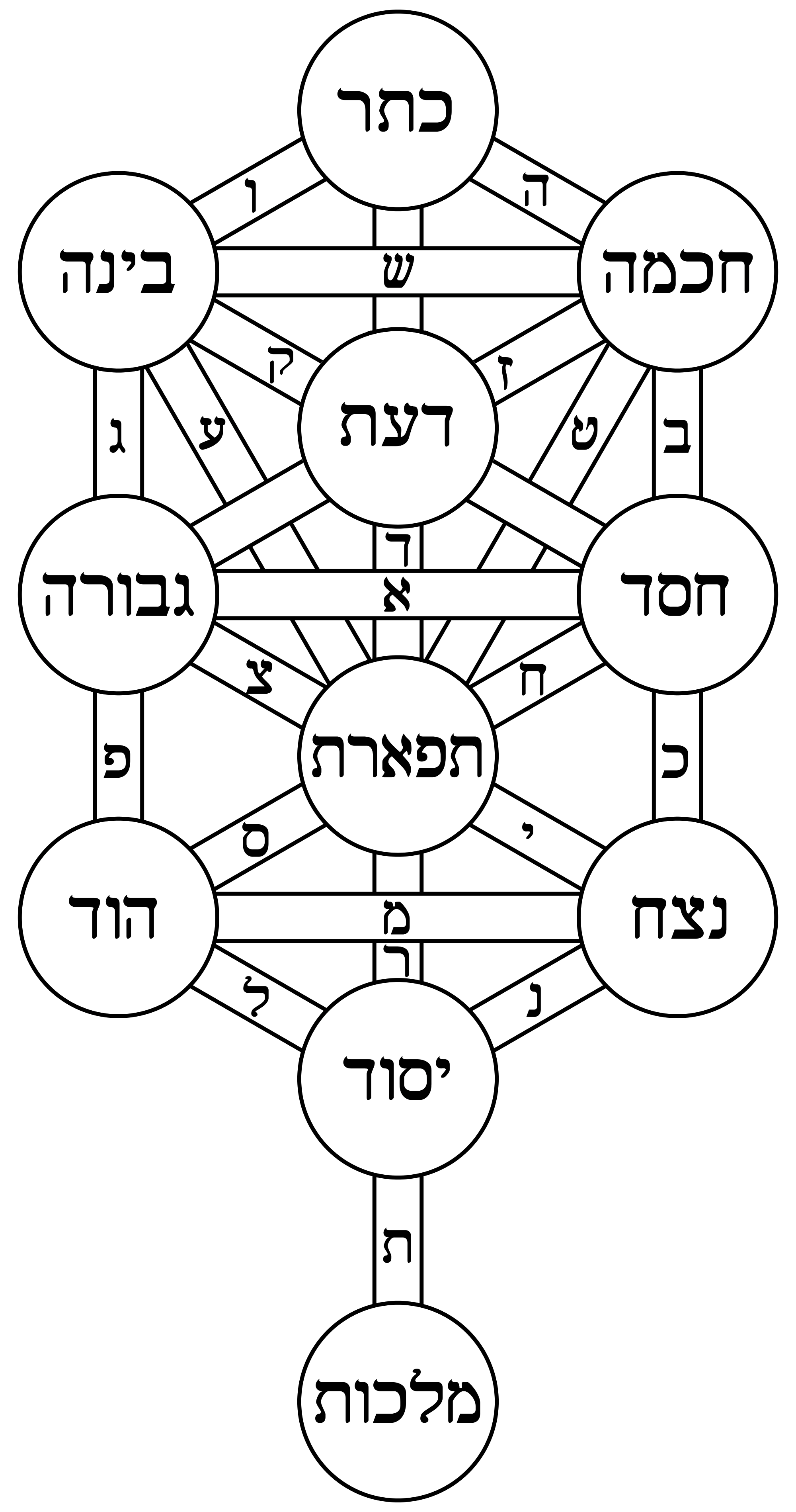
The Tardis, as a Divine and infinite being, is able to contain within her the whole of reality. Her potential is endless, limitless. The journey our heroes make through her within the course of the episode are therefore a reflection of the nature of life and death.
The nature of the Tardis as a creative force is nowhere more evident that when we encounter the actual physical World Tree within her. This World Tree contains the potential to create everything that could be.
Sensor: Everthing.
Gregor: What? Report.
Sensor: Everything behind that door.
Gregor: What?
Sensor: Sensor detects everything you could possibly want.
Gregor: Give me a price tag.
Sensor: Incalculable.
I could barely contain my glee when Gregor opened the door on the word “everything” and lo and behold there was the World Tree in physical form.
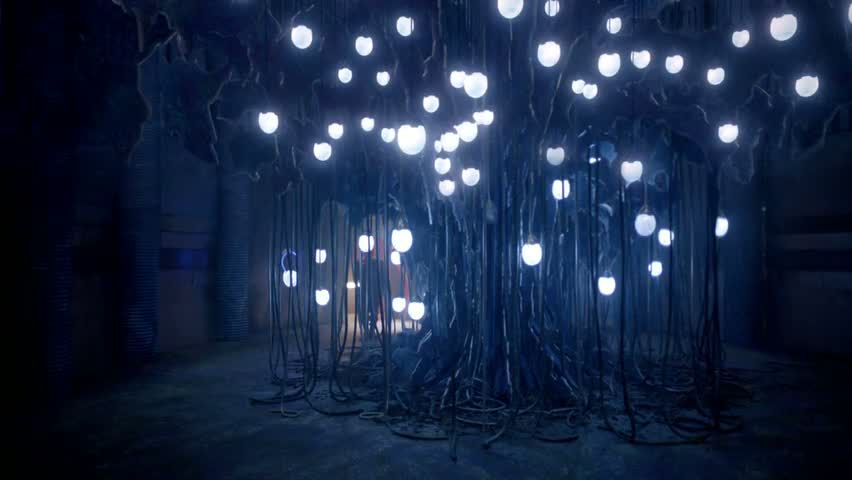
Doctor: Architectural reconfiguration system. It reconstructs particles according to your needs.
The fruits/circuits of the tree are egg shaped (remember all the egg symbolism that was threaded through series 7a?), and eggs are of course a symbol of gestation, birth, new life. The Tardis World Tree is the essence of pure creation -it has the power to effect reality in the form of reconstructing basic particles. It can create anything and everything. Not only that, it is a fundamental part of her own body. This is the power of a Goddess, the infinite power to create out of nothingness.
Each circuit/fruit/egg has circular Gallifreyan on it. The thing about circular Gallifreyan is that as a language it too represents the endless nature of reality, the principle of life/death/rebirth moving in a constant cyclical flow rather than a linear way. The very form of circular Gallifreyan is similar to the symbol of the Ouroboros, which is an extremely ancient symbol of a snake/serpent biting its own tail found across many cultures at different times It represented the cyclical nature of life and the ability to self-create.
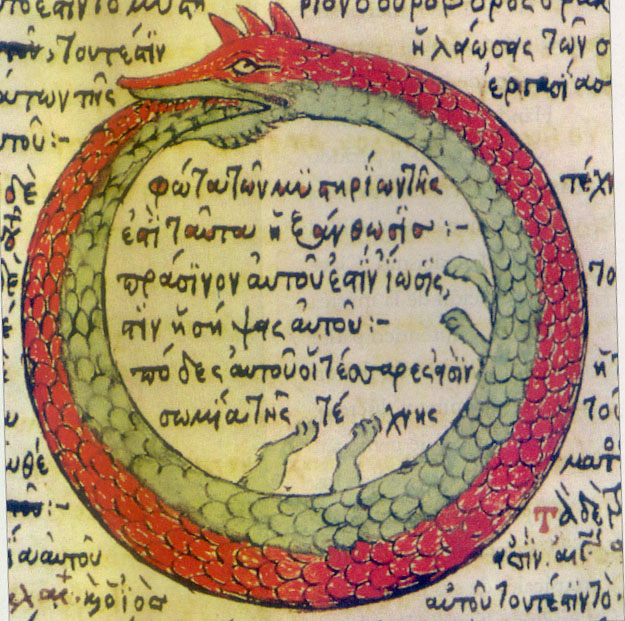
Along with the Kabbalistic World Tree and the physical tree inside her, we have what - for us - has for so long been the heart of the Tardis; we have the Control Room and the Console. The Console and Time Rotor, extending from the ceiling down into the roots of the ship, and decorated with the cyclical images of circular Gallifreyan, physically resembles a tree in some ways. The Console/Time Rotor can be read as a symbolic World Tree, and the underneath of the Platform as the Underworld. One of the main themes we are dealing with in this episode is Death, and the Underworld is traditionally the ream of the Dead (notably in Norse mythlology, where the world of the Dead is located underneath the roots of the World Tree Yggdrasil.)
Gregor sends Bram off to strip the Console down, in a mirror of himself stealing the fruit/circuit of the World Tree. When Bram opens up the Tardis console, he begins to hear voices from the past spilling out. These voices lead him to the underneath of the platform, and then to prise open the belly of the ship. He discovers a hatch and a ladder that leads down alongside the roots of the Time Rotor. Ladders are often associated with Ascension in Who, but of course they also have a dual function and can be used as a bridge to transition between both Underworld and Upperworld. The Underworld is the realm of the Dead - this is where Bram literally ends up. His symbolic journey into the Underworld brings him face to face with a future dead version of himself, and makes the symbolic journey into a real one - when he himself ends up dead.
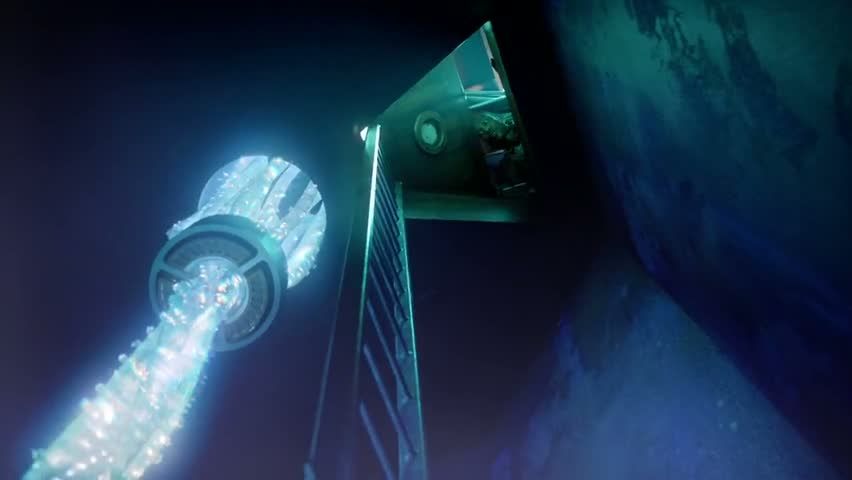
The Road of Trials and The Meeting With the Goddess
In the second stage of Joseph Campbell's Monomyth, which I’ve discussed in previous meta on series 7b, Clara has firmly left behind the Ordinary World, and is now fully in the Special Place - the world of the Doctor. This is the stage known as Initiation, and part of it is that the Hero has to undergo a series of trials and tests in order to win the prize which they have journeyed to the Special Place to gain, or to receive the lesson they have travelled there to learn. The tests that Clara have been facing so far have revolved mostly around the acceptance of her own mortality, and dealing with the fact that everything ends. Once again, in this episode, she is faced with this lesson.
When Clara lets the future version of herself in to the Tardis Control Room - shortly before she nearly dies - she stands facing herself across the Console. She and the dead version of herself look into each others eyes, and for a few moments they mirror each other's movements. She asks who the being is, and they stand face to face considering each other for a moment. In The Rings, Clara used the energy and acceptance of her mother's own mortality to vanquish the Sun God. In Cold War she faced the mortality of those around her as they were ripped to shreds by the Ice Warrior. In Hide she faced the conceptual idea that she was both dead and had never been born to the Doctor. There's been a definite progression in these lessons. Now, she at last comes face to face with her own dead self, literally.
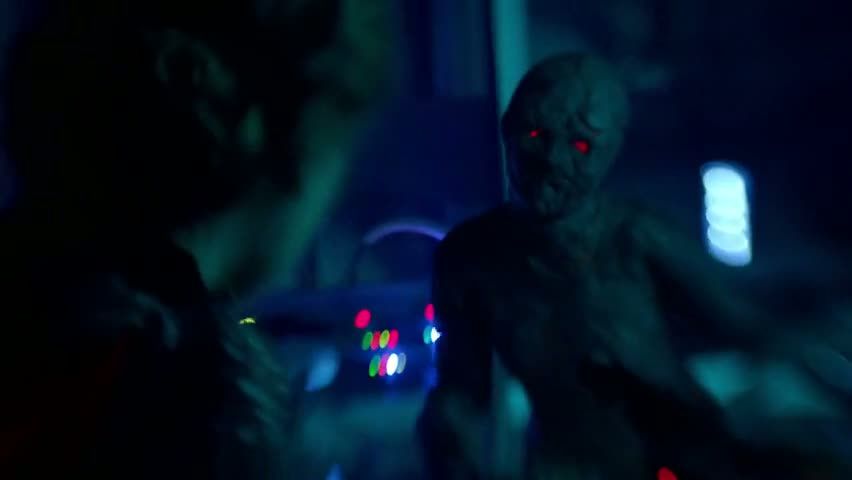
Surely this is one of the hardest lessons of all? Acceptance of your own mortality; witnessing your own death and yet surviving.
Thing is, this lesson is taking place for all our characters in this episode. All of them face future dead versions of themselves. The brothers are consumed by it. The Doctor faces this lesson too - but what does he do in the face of it? He denies it.
Clara: You’re gonna tell me right now, if we’re gonna die here you’re going to tell me what they are!
Doctor: I can’t.
Clara: Tell me! What’s the use in secrets now?
Doctor: Secrets protect us. Secrets make us safe.
Clara: We’re not safe!
In my meta on The Rings of Akhaten, I talked about the fact that the reason Clara was able to vanquish the Sun God is precisely because she is a mortal, and she held in her hands the leaf which was the symbol of true life and death. The reason the Doctor could never win that battle is because his death/resurrection in the form of regeneration is not a true death. He does not - cannot - know death itself. In his current character arc, he cannot admit it, cannot face Clara's death as his actions here show. Clara, though, is miles ahead of him in accepting what has happened to her. After all, this is the precise lesson she has been working with now for the last few episodes.
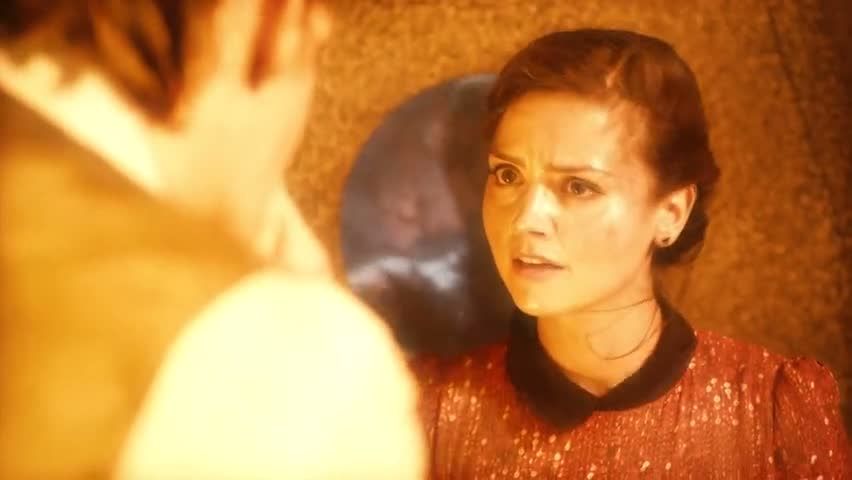
Sensor: Sensor detects animal DNA. Human core element. Calculating data. Calculating data. Lancashire. South. Identifiable substance. Clara.
Clara: That’s me.
Doctor: I’m so sorry.
Clara: That’s me. I burn in here.
Doctor: It isn’t just the past leaking out through the Time rift, it’s the future. Listen, I brought you here to keep you safe, but it happened again. You died again.
Clara: What do you mean again?
She turns around and faces the dead version of herself through the porthole (again, remember all the porthole type images in Asylum?), and we see her face mirrored along with that of the future her.
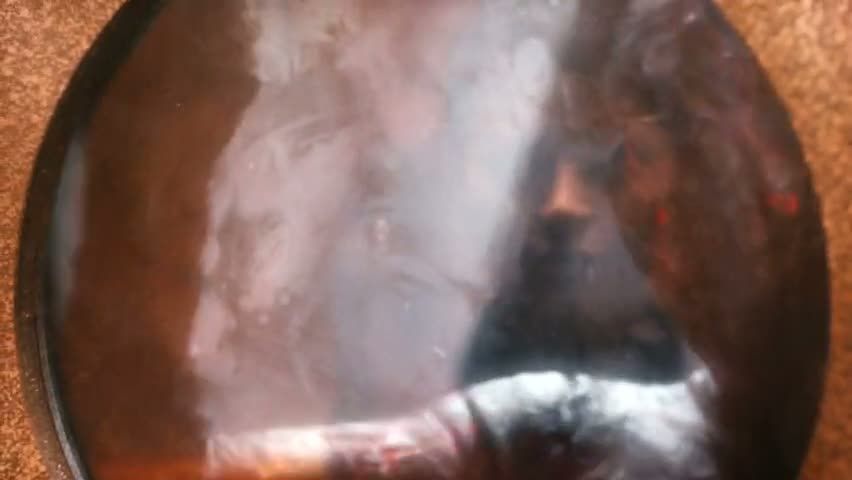
Later, on the bridge between the Eye of Harmony room and the centre of the Tardis, alongside a yawning gulf, Clara receives her next lesson. It's partially about the acceptance of imminent death. However, for me it feels as if Clara has been through these now and proven herself 3 times over with the first half of the series. Here she finds out that he does not accept her for who she knows herself as. She learns that she may not really know herself. That there is something deeply unusual about her.
Clara: If you don’t have a plan we’re dead.
Doctor: Yes. We are. So just tell me.
Clara: Tell you what?
Doctor: Well, there’s no point now, we’re about to die. Just tell me who you are.
Clara: You know who I am!
Doctor: No I don’t. I look at you every day and I don’t understand a thing about you. Why do I keep running into you?
Clara: Doctor, you invited me, you said-
Doctor: Before, I met you at the Dalek Asylum, there was a girl in a shipwreck. She died saving my life, and she was you.
Clara: She really wasn’t.
Doctor: Victorian London, there was a governess who was really a barmaid, and we fought the Great Intelligence together, she died and it was my fault, and she was you!
Clara: You’re scaring me.
Doctor: What are you eh? A trick? A trap?
Clara: I don’t know what you’re talking about!
(Clara nearly falls off the edge of the cliff, he grabs her and pulls her into his arms)
Doctor: You really don’t, do you?
Clara: I think I’m more scared of you right now than anything else on that Tardis.
Doctor: You're just Clara, aren’t you?
In some ways this is a mirror of the lesson that she faced in Hide. There, the Doctor took her to the beginning and the end of the Earth, and she saw that to him she had both never been born, and was dead at the same time, that her bones were out there somewhere. Here, she finds out she is from both the past and future, and that for the the Doctor, both versions of her are dead.
Significantly here, in a mirror of his earlier reluctance to tell her that a future version of herself has dies on board the Tardis, she forgets these events and we don't see him remind her of them. This is problematic for him. Clara's not the only one on a journey to acceptance here.
We all know, that at the moment the Doctor has this huge thing going on about his name. He does not want his true name/identity to be revealed. For whatever reason he is symbolically unable to own and accept that part of himself. However, this is acting out in the form of him projecting this onto Clara by denying her the own ability to have self knowledge of her potential true nature. This is bad, because the Doctor, as the Hero's mentor, should be facilitating self knowledge. Yes, the mentor may challenge the Hero, may cloak the answer to the quest for self knowledge in puzzles and challenges...but to allow someone to forget the self knowledge they have gained? This is projection of his own issues onto her. Adn how can someone be a mentor and a doorway into self knowledge, when they are in such denial adout their own identity?
Interestingly, linking with this, in the comments to my meta on Hide, bloodpara asked me what my thoughts were on the fact that at the moment, the Doctor's sonic seems to be malfunctioning a lot. After some thought and some rambling, my answer was this, and I see now how it very very much links in with this denial and projection:
Hmm, the sonic screwdriver...that's a damn good point and not one i'd really thought of. On a mythic/archetypal level, the sonic is the equivalent of the wizard's magic wand. The psychic interface means it is literally controlled by the power of the mind and the will of the user. If it's malfunctioning, it'd suggest some type of gulf inside him that's widening, separating him from his will that usually allows him to accomplish the "good" things with the screwdriver. I'm sure this sliver of ice is linked to his name and identity. Psychologically, I'd say the Doctor is more and more aware he's coming to the point of revelation of his name and identity - but that it is shrouded in such deep darkness that he's in denial. He clearly wants to totally forget this dark secret at the heart of himself. Thing is, you can't deny your Shadow Self, you have to accept and embrace it - otherwise you aren't whole. Him running faster and faster from his name, means his identity is more and more fractured.
That was a lot of rambling, but i was thinking as i was typing! So yeah, i think him denying his true name as it draws closer is fracturing himself. To wield magic properly, a the wizard has to be in balance. That isn't possible when parts of the self are disowned. There's also a tradition of names granting power in fairy stories. If he won't accept his own name...really he's draining off one of the biggest sources of his own power :)
*
After, or intertwined with The Road of Trials stage of this second phase of the Monomyth, are a number of phases called the Meeting With the Goddess, Woman as Temptress and Atonement with the Father. This journey to the heart of this creative, infinite being can definitely be read as this stage.
Christopher Vogler in The Writer's Journey, a modern book dealing with the Monomyth, calls this whole stage the Ordeal and outlines how this stage is represented by some sort of an approach to an innermost cave, where the Hero encounters threshold guardians (the Tardis herself and the dead versions of the characters), where illusion is rife in order to seduce the Hero from the path (the Tardis re-configuring the ship architecture), and where the stakes are higher than ever before (averting a visible future death). Joseph Campbell has this to say about this stage:
This is the crisis at the nadir, the zenith, or at the uttermost edge of the earth, at the central point of the cosmos, in the tabernacle of the temple, or within the darkness of the deepest chamber of the heart. The meeting with the goddess (who is incarnate in every woman) is the final test of the talent of the hero to win the boon of love (charity: amor fati), which is life itself enjoyed as the encasement of eternity. And when the adventurer, in this context, is not a youth but a maid, she is the one who, by her qualities, her beauty, or her yearning, is fit to become the consort of an immortal.
Christopher Vogler says this:
The simple secret of the Ordeal is this: Heroes must die so that they can be reborn.
Often in the Journey, the meeting with the Goddess occurs after the tests have been overcome, and is where the Hero experiences the power of love and finds peace and acceptance in the Universe. The thing with the Heroic Journey, is that the stages above don’t always happen in order and are sometimes mixed and blended together. It can be hard to discern, until the full narrative has played out, how a character is fitting into it. The thing that Clara finds at the heart of the Tardis is first death, and then rebirth. It’s both being alive and being dead at the same time - it’s the layers of life and time held together in the core of the Goddess. She wins the acceptance of the Doctor as he realises that she is a real girl, as much as Tricky is a real boy rather than an android. He, the immortal, accepts her as his “consort.”
One of the other (unfortunately named) stages close to the Meeting With the Goddess in Campbell's Monomyth is the Woman as Temptress stage. This is where the Hero encounters a moment of betrayal, crisis, abandonment or disappointment within this arena of Love. We have this represented here in the revelation of the Docotr's mistrust for her, and his betrayal of her confidence in misleading her about his true reasons for taking her with him.
Atonement with the Father...this is often the Hero's acceptance of the thing that holds ultimate power over their life. This is usually death, although it can be read at a superficial level as the Doctor currently having power over Clara's life as he controls the times and places where she goes. This idea may develop in future episodes, but I;m going to hazard a guess that both Clara's acceptance as the future dead version of herself, and the Doctor's acceptance of her as a real girl link into this stage.
Lastly, to pass thruogh to the true inner sanctume of the Goddess require a leap of faith, a stepping out into a a chasm, as in the case of the Fool card of the Tarot's Major Arcana.


There's so much more I could write about the Monomyth here, but I am really out of time and energy. I'll just point out that the ultimate healing of the Tardis, and the avoidance of death is once again linked into the idea of song/music.
Doctor: I need to find the moment we crashed, I need to find…the music.
The Doctor uses the sonic to tune into the music that was playing at the moment they crashed in order to provide the Big Friendly Button they need to escape their fate. Song saves. Again.
(There is also a theme of the tolling of bells, with the Bells of Saint John in the first episode when the Tardis external phone rang, the Cloister Bell in the last episode, and now the Cloister Bell again in this episode.)
*
Odds and Ends of other stuff
This section is a bit of a race through other stuff I noticed....
Family
Family - the theme of family is here yet again. Is Moffat trolling us, or is Clara related to the Doctor?
Every single episode now seems to be hinting at some sort of family connection between them, with the constant theme of family present in each one. Here, in the supporting characters, we have a family member who is treated as something non-human. Tricky is someone who believes they are something other than they are. There is a very clear mirror between him and Clara and a link to the the way that the Doctor is conceiving of and treating Clara. He sees her as something non-human. He conceals facts about her identity from her, just as the Van Baalens are doing to their brother Tricky. Just as Tricky’s true identity as human is revealed to him, so Clra’s identity as something very strange indeed is revealed to her by the Doctor. She learns the truth of herself having died twice, and also learns the truth of what the Doctor truly suspects of her. In the end, just as Gregor finds his humanity and cannot kill Tricky by cutting his arm off, the Doctor accepts that Clara has no idea that she could be some type of trap, or that there have been other versions of her through time. He accepts her as Clara Oswald.
The Doctor
It’s the second time that he’s threatened to destroy something in order to get what he wants. It mirrors his actions in Cold War when he threatened to blow up the whole sub is the Ice Warrior set off a nuclear warhead. Now he threatens to blow up that which he loves the most, to destroy them all. It feels like this Doctor is on some type of symbolic self-destruct mission. As i mentioned above, I also believe that his own desire to avoid the revelation of his name, and that that symbolises his denial of self-knowledge, is causing him to project onto Clara and to deny her the ability to know herself. To some extent, there are elements of role reversal going on - Clara seems, to me, to be forging ahead in the lessons she is learning about mortality and acceptance, where the Doctor seems....stuck.
The Eyes Have It
Eye imagery was something we saw a lot of in early Moffat-era Who. The theme of seeing and perception was prevalent in series 5 particularly. It’s been there all the way through though, and there’s lots of it in this ep, from the eyes of Tricky, the android who isn’t an android, to the Eye of Harmony. Note, also, the red and blue tones throughout these images.
Considering the Tricky/Clara mirror, it's apt that his eyes and the veiw from them resemble the Dalek Oswin's views from within Asylum.
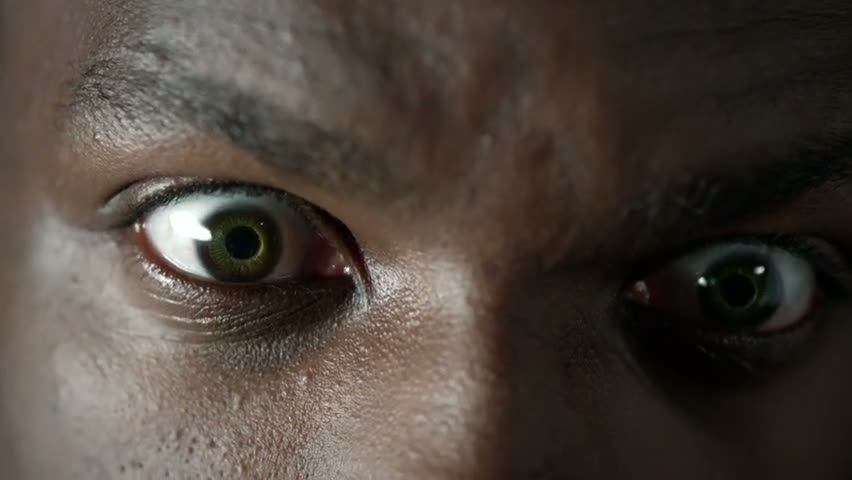
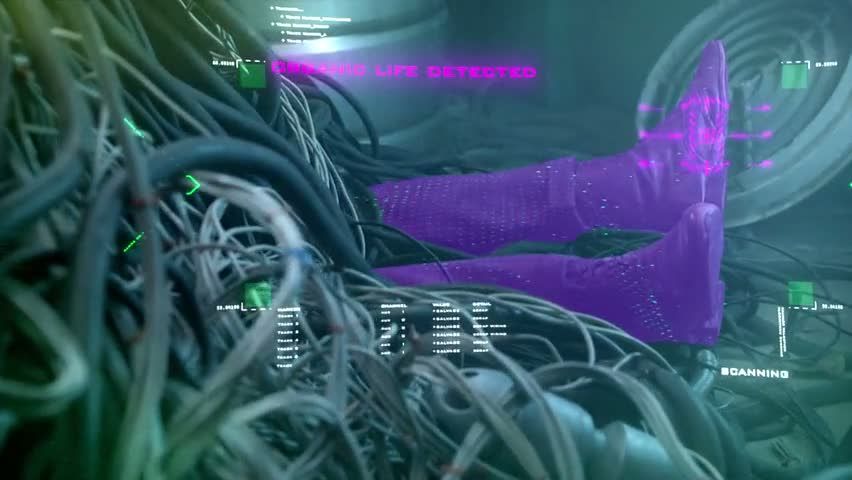
The magnetic field of the magna-grab looks like an eye.

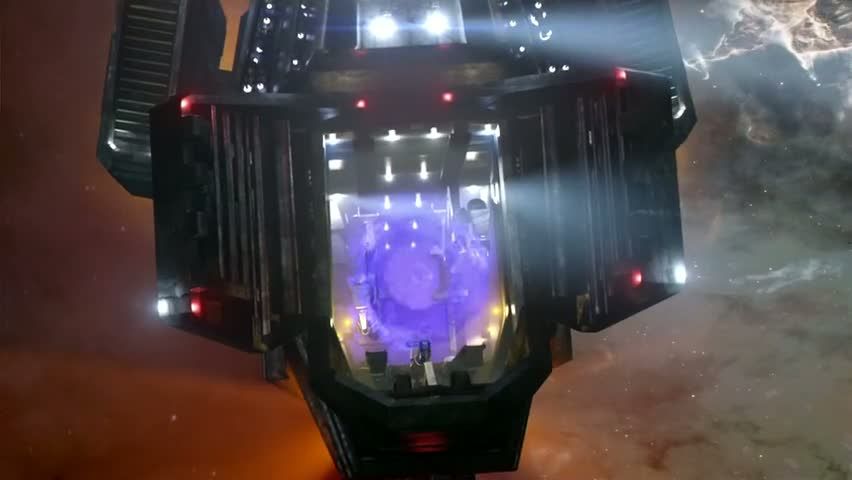
The Galaxy on the cracking console screen is also eye like. Then, of course, there are the glowing red eyes of the future burned up selves of the characters. There are lights on the Tardis that resemble eyes, and which are, again, reminiscent of the many porthole and circularly framed shots in Asylum.
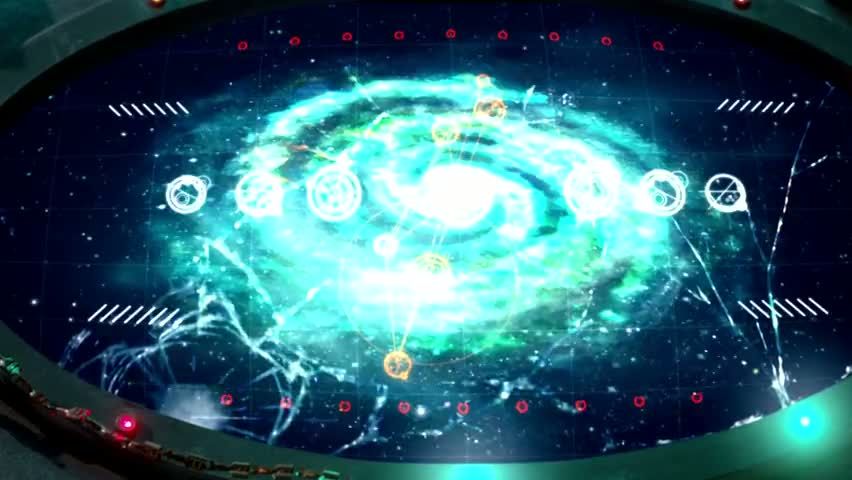
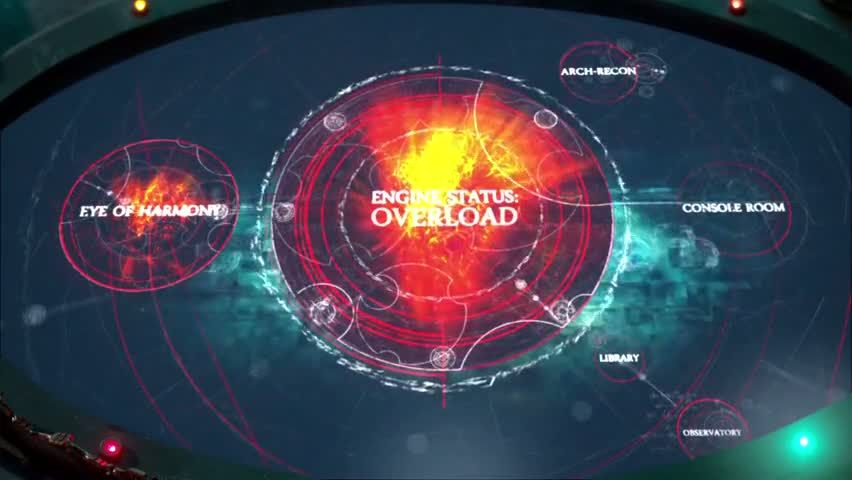
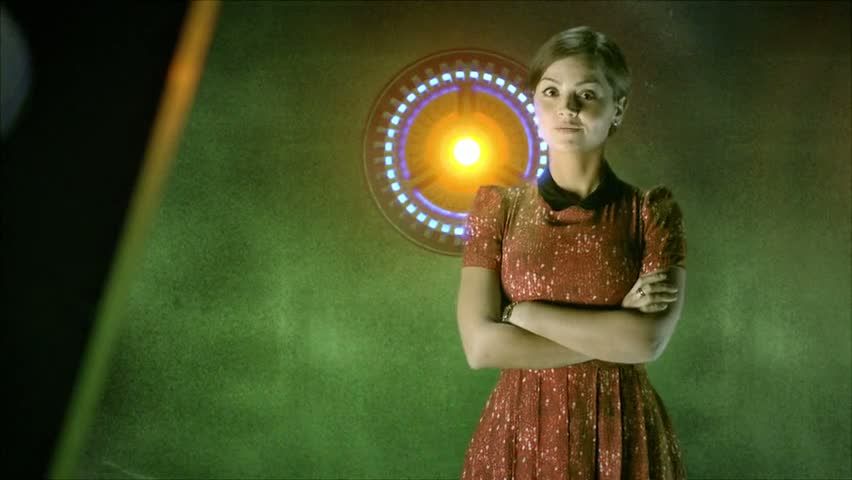
Lastly, there is also the Eye of Harmony, which is a juxtaposition of opposites. Decay held in stasis.
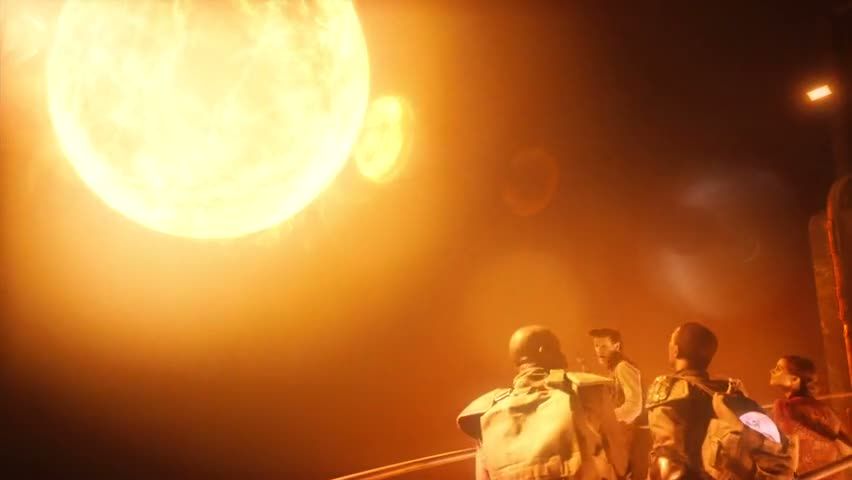
Doctor: The Eye of Harmony, exploding star in the act of becoming a black hole. Time Lord engineering, you rip the star from its orbit, suspend it in a state of permanent decay.
The X Motif
This is a symbol often used in Moffat’s Who and that I've written about often in the past. The X symbol is used in circumstances where there is some type of mirroring, connection, transaction of energy or crossing over going on. We see it here first behind the picture of the Van Baalen family, but with the android brother ripped off, we also see it as the Tardis appears on the monitors of the salvage vessel. The character mirror of Tricky/Clara and the idea of family connections links aptly to the use of this symbol here.
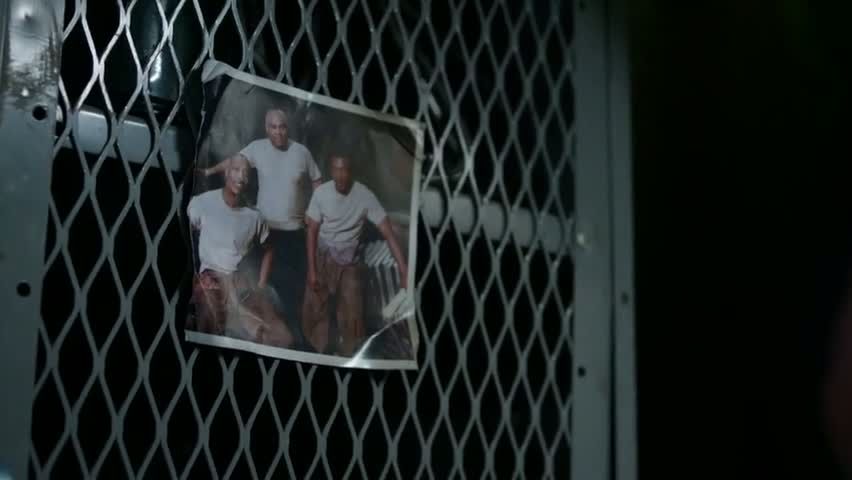

The Tardis also begins mirroring the Doctor and Clara back to themselves. As they make the journey to the centre of the Tardis, Clara again faces mirror versions of herself, just as she did in Hide. The rupture means that the Tardis is leaking the two of them through, recent things that they have done.Immediately after these instances of mirroring, the fuel rods start to snap and break through the wall, creating the X Motif.

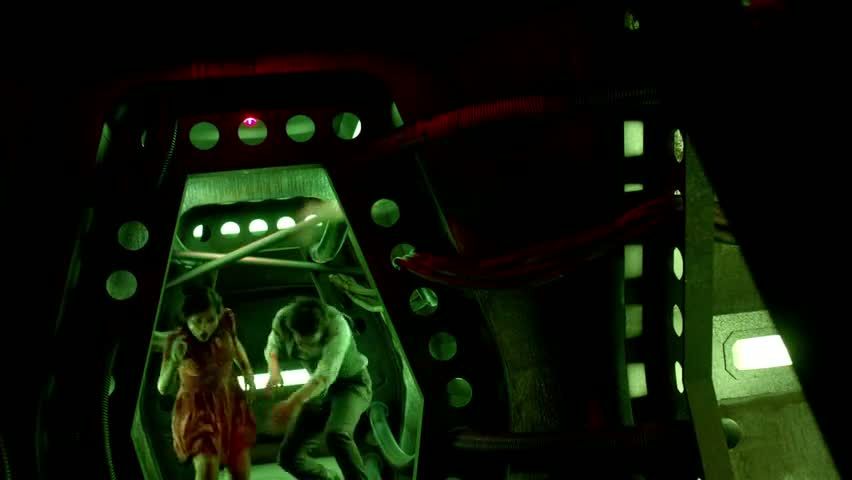
Tardis Interior
Immediately after the crash, Clara lies underneath a circle in a square, and often used symbol of achieving the impossible and juxtaposition of opposites (yep, re-use of props, but the symbolism is there nonetheless.)
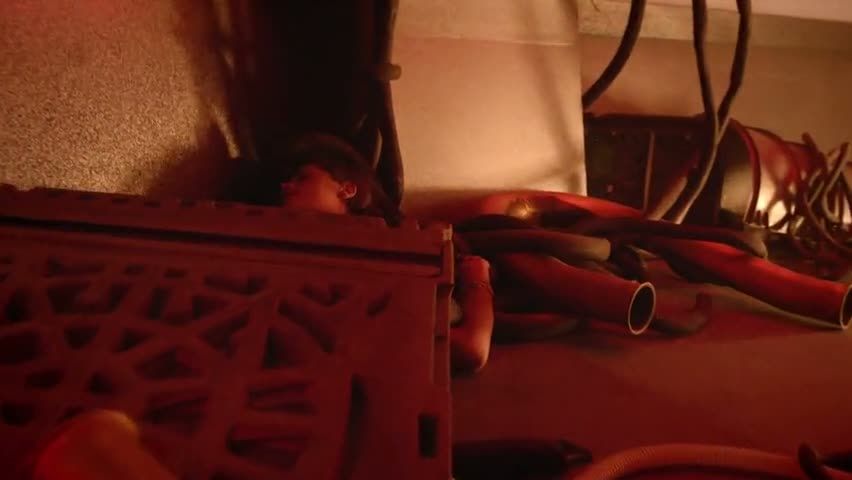
The colours of red and blue (fire and water) are all over the place and the first door she opens, opens onto fire. There are also fires burning in the Control Room.
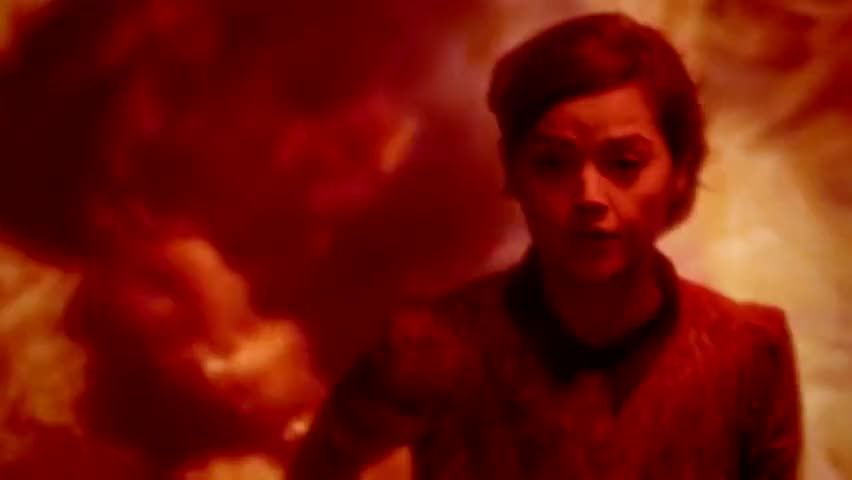
The next thing she opens the door to after the fire is the room containing the Doctor’s cot, which was also Melody Pond’s cot for a short time. Then she puts her hands on a Tardis model….is this the same model that Amy made, and which Mels once handled? She spins it round in her hands - in a way which very much reminded me of the way Mels handles the model in Let’s Kill Hitler. River's here again, in spirit.
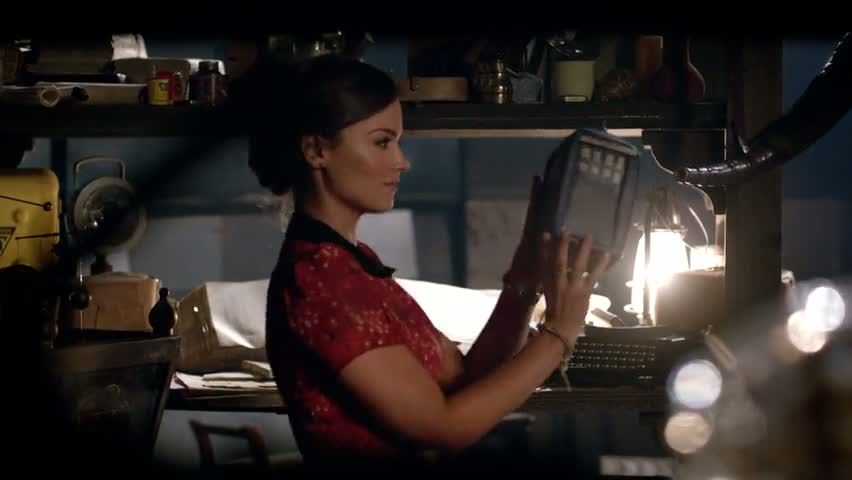
After that, we see an observatory with what might be the telescope from Tooth and Claw that focuses moonlight???? Immediately after that it’s the swimming pool. There’s a link there between the power of moonlight and of water. Moonlight/water are both seen in occult terms as things associated with the subconscious, with memories, dreaming, with seeing things in a different light - and also with death.
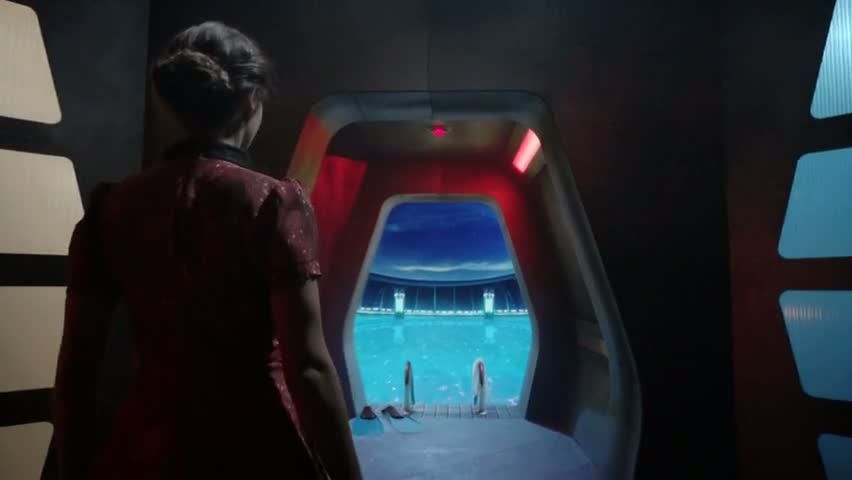
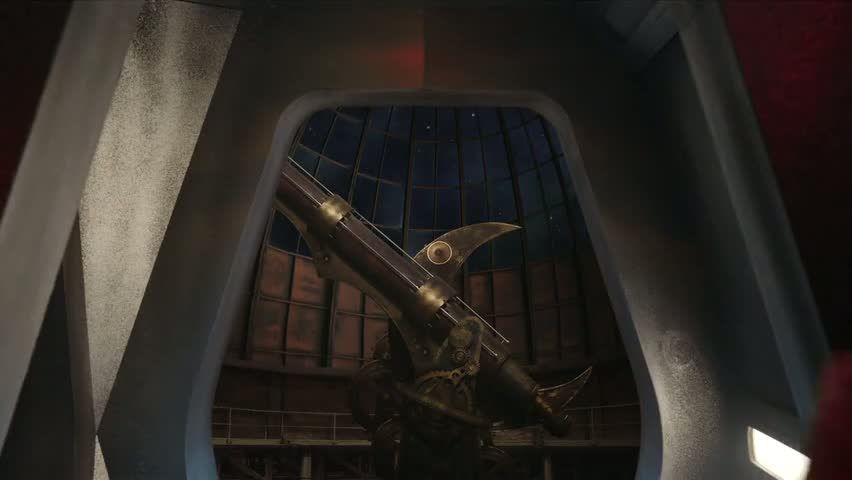
The next place she gets to is the Library. Echoes of River Song are very much here again. Especially since River is the only one who we know knows his name....until this moment when Clara discovers it. River reveals to him she knows his name in the Library where she dies. Clara discovers his name in the library where she encounters her dead self. Clara and River are mirrored.
The bottled essence of the Encyclopedia Gallifreya contains the infinity symbol.
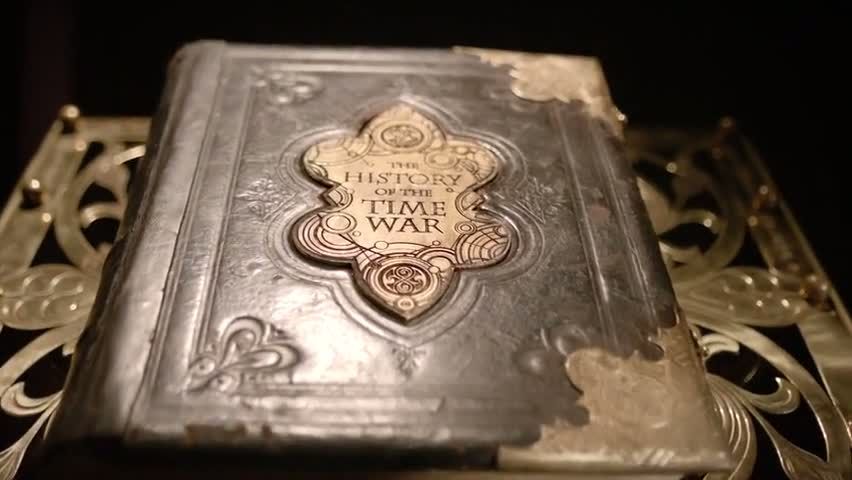
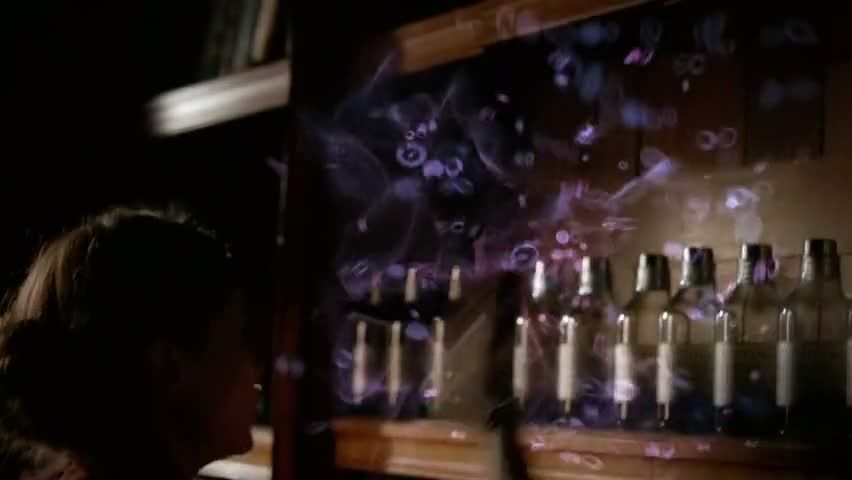
There's links to the idea of echo Universes that was explored in Hide. The Tardis creates echoes of the Control Room to try and create a safe space for the people on the ship to be. An echo is also a mirror
Doctor: It’s an echo…the Console Room is the safest room on the ship, it’s trying to protect us.
Doctor: There’s more than one echo room….it’s like a light switch flickering at super infinite speeds, we’re only together for a second.
Lastly, Moffat's little nod to his own storytelling. Since the start, Clara/Owsin seesm to have had the ability to break the fourth wall/threaten the narrative. We see it here, as she questions the type of myth the Doctor is.
Clara: What do you keep in here? Why have you got zombie creatures? Good guys do not have zombie creatures, rule one basic storytelling!
Thanks for reading.
The World Tree and Tardis as Goddess
For a while I've been going on and on about World Tree symbolism in Moffat's Who, which, in this series, has become overt. The World Tree is a spiritual symbol found across many cultures and time periods, that uses the image of a Tree in order to depict life, the Universe and everything. It portrays the forces that make up reality, and the journey of living things within that reality.
In this episode, the Tardis herself is represented as containing a literal tree which has the ability to pattern particles and to create anything the user desires. For me, this core part of the Tardis symbolises that both the Tardis herself is a symbol of the World Tree and that she is the equivalent of the force that creates the World Tree/Universe. She represents the force that lies behind reality. We're shown over and over in this episode, both in dialogue and in plot events, that the Tardis is a complex, living, creative, vastly powerful entity with infinite form, with the power to both create and destroy held in balance (also represented by the Eye of Harmony), a being with powers of a Goddess. That the Tardis represents the Goddess is also very relevant when it comes to looking at where this episode might fit in the structure of Joseph Campbell's Heroic Journey.
The circular Gallifreyan patterns behind the self-destruct countdown on the monitor resemble the structure and spheres of the Kabbalistic World Tree. The Kabbalistic World Tree, from the esoteric Judaic system, depicts a series of spiritual principles in the form of spheres that are connected together in the abstract form of a Tree of Life. These principles describe how the Universe was created out of nothingness by the Divine, how the Divine can be discerned in the world around us, the path of the human soul through reality, and how the soul ascends by becoming closer to the Divine. The Kabbalistic World Tree is essentially a map of God(dess), reality, the entire nature of the Universe and the role of living things within it. It's everything. Note the similarity between the circular Gallifreyan and the traditional depiction of the Tree.



The Tardis, as a Divine and infinite being, is able to contain within her the whole of reality. Her potential is endless, limitless. The journey our heroes make through her within the course of the episode are therefore a reflection of the nature of life and death.
The nature of the Tardis as a creative force is nowhere more evident that when we encounter the actual physical World Tree within her. This World Tree contains the potential to create everything that could be.
Sensor: Everthing.
Gregor: What? Report.
Sensor: Everything behind that door.
Gregor: What?
Sensor: Sensor detects everything you could possibly want.
Gregor: Give me a price tag.
Sensor: Incalculable.
I could barely contain my glee when Gregor opened the door on the word “everything” and lo and behold there was the World Tree in physical form.

Doctor: Architectural reconfiguration system. It reconstructs particles according to your needs.
The fruits/circuits of the tree are egg shaped (remember all the egg symbolism that was threaded through series 7a?), and eggs are of course a symbol of gestation, birth, new life. The Tardis World Tree is the essence of pure creation -it has the power to effect reality in the form of reconstructing basic particles. It can create anything and everything. Not only that, it is a fundamental part of her own body. This is the power of a Goddess, the infinite power to create out of nothingness.
Each circuit/fruit/egg has circular Gallifreyan on it. The thing about circular Gallifreyan is that as a language it too represents the endless nature of reality, the principle of life/death/rebirth moving in a constant cyclical flow rather than a linear way. The very form of circular Gallifreyan is similar to the symbol of the Ouroboros, which is an extremely ancient symbol of a snake/serpent biting its own tail found across many cultures at different times It represented the cyclical nature of life and the ability to self-create.

Along with the Kabbalistic World Tree and the physical tree inside her, we have what - for us - has for so long been the heart of the Tardis; we have the Control Room and the Console. The Console and Time Rotor, extending from the ceiling down into the roots of the ship, and decorated with the cyclical images of circular Gallifreyan, physically resembles a tree in some ways. The Console/Time Rotor can be read as a symbolic World Tree, and the underneath of the Platform as the Underworld. One of the main themes we are dealing with in this episode is Death, and the Underworld is traditionally the ream of the Dead (notably in Norse mythlology, where the world of the Dead is located underneath the roots of the World Tree Yggdrasil.)
Gregor sends Bram off to strip the Console down, in a mirror of himself stealing the fruit/circuit of the World Tree. When Bram opens up the Tardis console, he begins to hear voices from the past spilling out. These voices lead him to the underneath of the platform, and then to prise open the belly of the ship. He discovers a hatch and a ladder that leads down alongside the roots of the Time Rotor. Ladders are often associated with Ascension in Who, but of course they also have a dual function and can be used as a bridge to transition between both Underworld and Upperworld. The Underworld is the realm of the Dead - this is where Bram literally ends up. His symbolic journey into the Underworld brings him face to face with a future dead version of himself, and makes the symbolic journey into a real one - when he himself ends up dead.

The Road of Trials and The Meeting With the Goddess
In the second stage of Joseph Campbell's Monomyth, which I’ve discussed in previous meta on series 7b, Clara has firmly left behind the Ordinary World, and is now fully in the Special Place - the world of the Doctor. This is the stage known as Initiation, and part of it is that the Hero has to undergo a series of trials and tests in order to win the prize which they have journeyed to the Special Place to gain, or to receive the lesson they have travelled there to learn. The tests that Clara have been facing so far have revolved mostly around the acceptance of her own mortality, and dealing with the fact that everything ends. Once again, in this episode, she is faced with this lesson.
When Clara lets the future version of herself in to the Tardis Control Room - shortly before she nearly dies - she stands facing herself across the Console. She and the dead version of herself look into each others eyes, and for a few moments they mirror each other's movements. She asks who the being is, and they stand face to face considering each other for a moment. In The Rings, Clara used the energy and acceptance of her mother's own mortality to vanquish the Sun God. In Cold War she faced the mortality of those around her as they were ripped to shreds by the Ice Warrior. In Hide she faced the conceptual idea that she was both dead and had never been born to the Doctor. There's been a definite progression in these lessons. Now, she at last comes face to face with her own dead self, literally.

Surely this is one of the hardest lessons of all? Acceptance of your own mortality; witnessing your own death and yet surviving.
Thing is, this lesson is taking place for all our characters in this episode. All of them face future dead versions of themselves. The brothers are consumed by it. The Doctor faces this lesson too - but what does he do in the face of it? He denies it.
Clara: You’re gonna tell me right now, if we’re gonna die here you’re going to tell me what they are!
Doctor: I can’t.
Clara: Tell me! What’s the use in secrets now?
Doctor: Secrets protect us. Secrets make us safe.
Clara: We’re not safe!
In my meta on The Rings of Akhaten, I talked about the fact that the reason Clara was able to vanquish the Sun God is precisely because she is a mortal, and she held in her hands the leaf which was the symbol of true life and death. The reason the Doctor could never win that battle is because his death/resurrection in the form of regeneration is not a true death. He does not - cannot - know death itself. In his current character arc, he cannot admit it, cannot face Clara's death as his actions here show. Clara, though, is miles ahead of him in accepting what has happened to her. After all, this is the precise lesson she has been working with now for the last few episodes.

Sensor: Sensor detects animal DNA. Human core element. Calculating data. Calculating data. Lancashire. South. Identifiable substance. Clara.
Clara: That’s me.
Doctor: I’m so sorry.
Clara: That’s me. I burn in here.
Doctor: It isn’t just the past leaking out through the Time rift, it’s the future. Listen, I brought you here to keep you safe, but it happened again. You died again.
Clara: What do you mean again?
She turns around and faces the dead version of herself through the porthole (again, remember all the porthole type images in Asylum?), and we see her face mirrored along with that of the future her.

Later, on the bridge between the Eye of Harmony room and the centre of the Tardis, alongside a yawning gulf, Clara receives her next lesson. It's partially about the acceptance of imminent death. However, for me it feels as if Clara has been through these now and proven herself 3 times over with the first half of the series. Here she finds out that he does not accept her for who she knows herself as. She learns that she may not really know herself. That there is something deeply unusual about her.
Clara: If you don’t have a plan we’re dead.
Doctor: Yes. We are. So just tell me.
Clara: Tell you what?
Doctor: Well, there’s no point now, we’re about to die. Just tell me who you are.
Clara: You know who I am!
Doctor: No I don’t. I look at you every day and I don’t understand a thing about you. Why do I keep running into you?
Clara: Doctor, you invited me, you said-
Doctor: Before, I met you at the Dalek Asylum, there was a girl in a shipwreck. She died saving my life, and she was you.
Clara: She really wasn’t.
Doctor: Victorian London, there was a governess who was really a barmaid, and we fought the Great Intelligence together, she died and it was my fault, and she was you!
Clara: You’re scaring me.
Doctor: What are you eh? A trick? A trap?
Clara: I don’t know what you’re talking about!
(Clara nearly falls off the edge of the cliff, he grabs her and pulls her into his arms)
Doctor: You really don’t, do you?
Clara: I think I’m more scared of you right now than anything else on that Tardis.
Doctor: You're just Clara, aren’t you?
In some ways this is a mirror of the lesson that she faced in Hide. There, the Doctor took her to the beginning and the end of the Earth, and she saw that to him she had both never been born, and was dead at the same time, that her bones were out there somewhere. Here, she finds out she is from both the past and future, and that for the the Doctor, both versions of her are dead.
Significantly here, in a mirror of his earlier reluctance to tell her that a future version of herself has dies on board the Tardis, she forgets these events and we don't see him remind her of them. This is problematic for him. Clara's not the only one on a journey to acceptance here.
We all know, that at the moment the Doctor has this huge thing going on about his name. He does not want his true name/identity to be revealed. For whatever reason he is symbolically unable to own and accept that part of himself. However, this is acting out in the form of him projecting this onto Clara by denying her the own ability to have self knowledge of her potential true nature. This is bad, because the Doctor, as the Hero's mentor, should be facilitating self knowledge. Yes, the mentor may challenge the Hero, may cloak the answer to the quest for self knowledge in puzzles and challenges...but to allow someone to forget the self knowledge they have gained? This is projection of his own issues onto her. Adn how can someone be a mentor and a doorway into self knowledge, when they are in such denial adout their own identity?
Interestingly, linking with this, in the comments to my meta on Hide, bloodpara asked me what my thoughts were on the fact that at the moment, the Doctor's sonic seems to be malfunctioning a lot. After some thought and some rambling, my answer was this, and I see now how it very very much links in with this denial and projection:
Hmm, the sonic screwdriver...that's a damn good point and not one i'd really thought of. On a mythic/archetypal level, the sonic is the equivalent of the wizard's magic wand. The psychic interface means it is literally controlled by the power of the mind and the will of the user. If it's malfunctioning, it'd suggest some type of gulf inside him that's widening, separating him from his will that usually allows him to accomplish the "good" things with the screwdriver. I'm sure this sliver of ice is linked to his name and identity. Psychologically, I'd say the Doctor is more and more aware he's coming to the point of revelation of his name and identity - but that it is shrouded in such deep darkness that he's in denial. He clearly wants to totally forget this dark secret at the heart of himself. Thing is, you can't deny your Shadow Self, you have to accept and embrace it - otherwise you aren't whole. Him running faster and faster from his name, means his identity is more and more fractured.
That was a lot of rambling, but i was thinking as i was typing! So yeah, i think him denying his true name as it draws closer is fracturing himself. To wield magic properly, a the wizard has to be in balance. That isn't possible when parts of the self are disowned. There's also a tradition of names granting power in fairy stories. If he won't accept his own name...really he's draining off one of the biggest sources of his own power :)
*
After, or intertwined with The Road of Trials stage of this second phase of the Monomyth, are a number of phases called the Meeting With the Goddess, Woman as Temptress and Atonement with the Father. This journey to the heart of this creative, infinite being can definitely be read as this stage.
Christopher Vogler in The Writer's Journey, a modern book dealing with the Monomyth, calls this whole stage the Ordeal and outlines how this stage is represented by some sort of an approach to an innermost cave, where the Hero encounters threshold guardians (the Tardis herself and the dead versions of the characters), where illusion is rife in order to seduce the Hero from the path (the Tardis re-configuring the ship architecture), and where the stakes are higher than ever before (averting a visible future death). Joseph Campbell has this to say about this stage:
This is the crisis at the nadir, the zenith, or at the uttermost edge of the earth, at the central point of the cosmos, in the tabernacle of the temple, or within the darkness of the deepest chamber of the heart. The meeting with the goddess (who is incarnate in every woman) is the final test of the talent of the hero to win the boon of love (charity: amor fati), which is life itself enjoyed as the encasement of eternity. And when the adventurer, in this context, is not a youth but a maid, she is the one who, by her qualities, her beauty, or her yearning, is fit to become the consort of an immortal.
Christopher Vogler says this:
The simple secret of the Ordeal is this: Heroes must die so that they can be reborn.
Often in the Journey, the meeting with the Goddess occurs after the tests have been overcome, and is where the Hero experiences the power of love and finds peace and acceptance in the Universe. The thing with the Heroic Journey, is that the stages above don’t always happen in order and are sometimes mixed and blended together. It can be hard to discern, until the full narrative has played out, how a character is fitting into it. The thing that Clara finds at the heart of the Tardis is first death, and then rebirth. It’s both being alive and being dead at the same time - it’s the layers of life and time held together in the core of the Goddess. She wins the acceptance of the Doctor as he realises that she is a real girl, as much as Tricky is a real boy rather than an android. He, the immortal, accepts her as his “consort.”
One of the other (unfortunately named) stages close to the Meeting With the Goddess in Campbell's Monomyth is the Woman as Temptress stage. This is where the Hero encounters a moment of betrayal, crisis, abandonment or disappointment within this arena of Love. We have this represented here in the revelation of the Docotr's mistrust for her, and his betrayal of her confidence in misleading her about his true reasons for taking her with him.
Atonement with the Father...this is often the Hero's acceptance of the thing that holds ultimate power over their life. This is usually death, although it can be read at a superficial level as the Doctor currently having power over Clara's life as he controls the times and places where she goes. This idea may develop in future episodes, but I;m going to hazard a guess that both Clara's acceptance as the future dead version of herself, and the Doctor's acceptance of her as a real girl link into this stage.
Lastly, to pass thruogh to the true inner sanctume of the Goddess require a leap of faith, a stepping out into a a chasm, as in the case of the Fool card of the Tarot's Major Arcana.


There's so much more I could write about the Monomyth here, but I am really out of time and energy. I'll just point out that the ultimate healing of the Tardis, and the avoidance of death is once again linked into the idea of song/music.
Doctor: I need to find the moment we crashed, I need to find…the music.
The Doctor uses the sonic to tune into the music that was playing at the moment they crashed in order to provide the Big Friendly Button they need to escape their fate. Song saves. Again.
(There is also a theme of the tolling of bells, with the Bells of Saint John in the first episode when the Tardis external phone rang, the Cloister Bell in the last episode, and now the Cloister Bell again in this episode.)
*
Odds and Ends of other stuff
This section is a bit of a race through other stuff I noticed....
Family
Family - the theme of family is here yet again. Is Moffat trolling us, or is Clara related to the Doctor?
Every single episode now seems to be hinting at some sort of family connection between them, with the constant theme of family present in each one. Here, in the supporting characters, we have a family member who is treated as something non-human. Tricky is someone who believes they are something other than they are. There is a very clear mirror between him and Clara and a link to the the way that the Doctor is conceiving of and treating Clara. He sees her as something non-human. He conceals facts about her identity from her, just as the Van Baalens are doing to their brother Tricky. Just as Tricky’s true identity as human is revealed to him, so Clra’s identity as something very strange indeed is revealed to her by the Doctor. She learns the truth of herself having died twice, and also learns the truth of what the Doctor truly suspects of her. In the end, just as Gregor finds his humanity and cannot kill Tricky by cutting his arm off, the Doctor accepts that Clara has no idea that she could be some type of trap, or that there have been other versions of her through time. He accepts her as Clara Oswald.
The Doctor
It’s the second time that he’s threatened to destroy something in order to get what he wants. It mirrors his actions in Cold War when he threatened to blow up the whole sub is the Ice Warrior set off a nuclear warhead. Now he threatens to blow up that which he loves the most, to destroy them all. It feels like this Doctor is on some type of symbolic self-destruct mission. As i mentioned above, I also believe that his own desire to avoid the revelation of his name, and that that symbolises his denial of self-knowledge, is causing him to project onto Clara and to deny her the ability to know herself. To some extent, there are elements of role reversal going on - Clara seems, to me, to be forging ahead in the lessons she is learning about mortality and acceptance, where the Doctor seems....stuck.
The Eyes Have It
Eye imagery was something we saw a lot of in early Moffat-era Who. The theme of seeing and perception was prevalent in series 5 particularly. It’s been there all the way through though, and there’s lots of it in this ep, from the eyes of Tricky, the android who isn’t an android, to the Eye of Harmony. Note, also, the red and blue tones throughout these images.
Considering the Tricky/Clara mirror, it's apt that his eyes and the veiw from them resemble the Dalek Oswin's views from within Asylum.


The magnetic field of the magna-grab looks like an eye.


The Galaxy on the cracking console screen is also eye like. Then, of course, there are the glowing red eyes of the future burned up selves of the characters. There are lights on the Tardis that resemble eyes, and which are, again, reminiscent of the many porthole and circularly framed shots in Asylum.



Lastly, there is also the Eye of Harmony, which is a juxtaposition of opposites. Decay held in stasis.

Doctor: The Eye of Harmony, exploding star in the act of becoming a black hole. Time Lord engineering, you rip the star from its orbit, suspend it in a state of permanent decay.
The X Motif
This is a symbol often used in Moffat’s Who and that I've written about often in the past. The X symbol is used in circumstances where there is some type of mirroring, connection, transaction of energy or crossing over going on. We see it here first behind the picture of the Van Baalen family, but with the android brother ripped off, we also see it as the Tardis appears on the monitors of the salvage vessel. The character mirror of Tricky/Clara and the idea of family connections links aptly to the use of this symbol here.


The Tardis also begins mirroring the Doctor and Clara back to themselves. As they make the journey to the centre of the Tardis, Clara again faces mirror versions of herself, just as she did in Hide. The rupture means that the Tardis is leaking the two of them through, recent things that they have done.Immediately after these instances of mirroring, the fuel rods start to snap and break through the wall, creating the X Motif.


Tardis Interior
Immediately after the crash, Clara lies underneath a circle in a square, and often used symbol of achieving the impossible and juxtaposition of opposites (yep, re-use of props, but the symbolism is there nonetheless.)

The colours of red and blue (fire and water) are all over the place and the first door she opens, opens onto fire. There are also fires burning in the Control Room.

The next thing she opens the door to after the fire is the room containing the Doctor’s cot, which was also Melody Pond’s cot for a short time. Then she puts her hands on a Tardis model….is this the same model that Amy made, and which Mels once handled? She spins it round in her hands - in a way which very much reminded me of the way Mels handles the model in Let’s Kill Hitler. River's here again, in spirit.

After that, we see an observatory with what might be the telescope from Tooth and Claw that focuses moonlight???? Immediately after that it’s the swimming pool. There’s a link there between the power of moonlight and of water. Moonlight/water are both seen in occult terms as things associated with the subconscious, with memories, dreaming, with seeing things in a different light - and also with death.


The next place she gets to is the Library. Echoes of River Song are very much here again. Especially since River is the only one who we know knows his name....until this moment when Clara discovers it. River reveals to him she knows his name in the Library where she dies. Clara discovers his name in the library where she encounters her dead self. Clara and River are mirrored.
The bottled essence of the Encyclopedia Gallifreya contains the infinity symbol.


There's links to the idea of echo Universes that was explored in Hide. The Tardis creates echoes of the Control Room to try and create a safe space for the people on the ship to be. An echo is also a mirror
Doctor: It’s an echo…the Console Room is the safest room on the ship, it’s trying to protect us.
Doctor: There’s more than one echo room….it’s like a light switch flickering at super infinite speeds, we’re only together for a second.
Lastly, Moffat's little nod to his own storytelling. Since the start, Clara/Owsin seesm to have had the ability to break the fourth wall/threaten the narrative. We see it here, as she questions the type of myth the Doctor is.
Clara: What do you keep in here? Why have you got zombie creatures? Good guys do not have zombie creatures, rule one basic storytelling!
Thanks for reading.